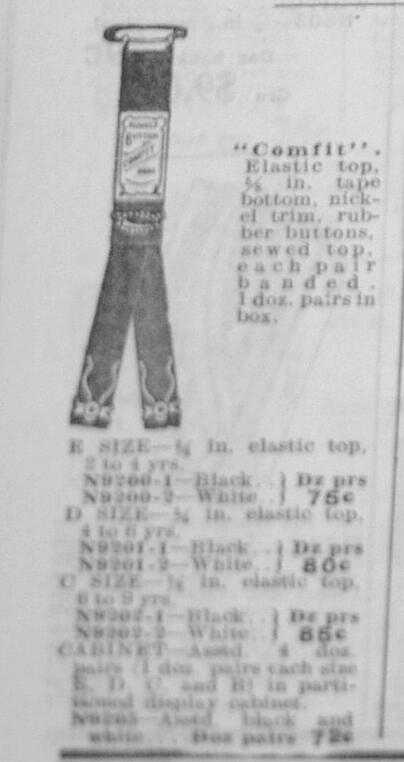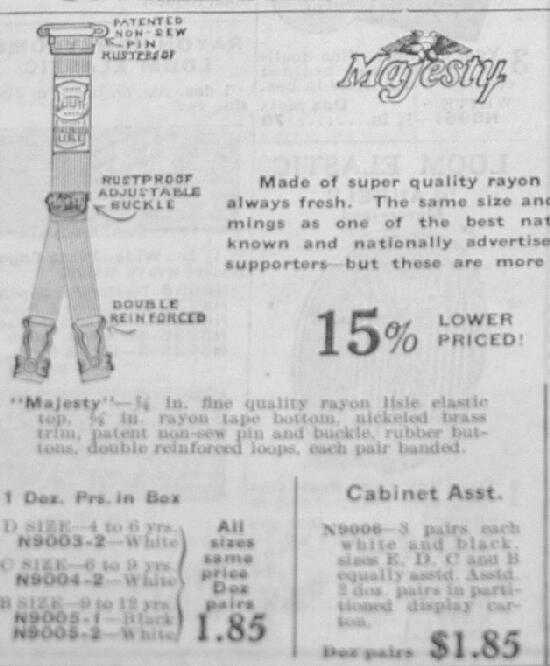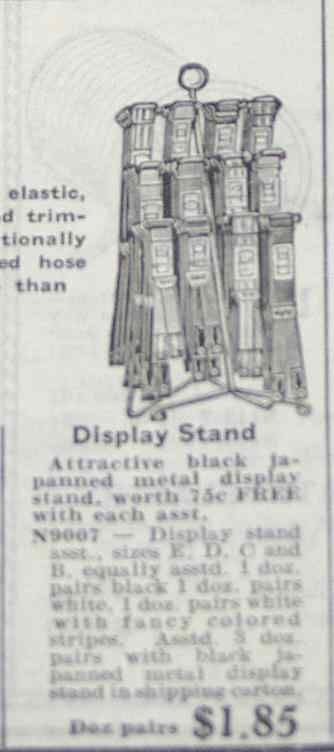
Figure 1.--This was one of the children's stocking supporters offered by the Butler Brothers wholesalers in 1929.


Figure 1.--This was one of the children's stocking supporters offered by the Butler Brothers wholesalers in 1929. |
Butler Brothers ran a wholesale company for clothing stores around the country. Their catalog was much like a Sears or Wards catalog, onlu aimed at merchants and the idets were sold whole sale in bulk. A page from their 1929 catalog offers details on garters for adults, stocking supporters for childrem and even children's suspenders. Esprecially interesting is that merchants were offered a stand with which to display their inventory of children's stocking supporters.
We have been unable to find a great deal of information about Butler Brothers. We know that the form was based in Chicago and New York. The New York store was located at 860 Broadway. The company was a major wholesaler in the United States. The Butler Brothers apparently founded the company in the 1870s as a small Boston retail store. We know that in the 1910s and 20s that they were a major wholesale clothing compamy, specializing in providing goods to small retailers. We are not sure what happened to the firm after 1929, perhaps it was a product of the Depression. We know of the firm as a clothing retailer, but they appear to have handled othr good as well, including books, even offering a "complete library". A Butler Brothers 1928 ad, for example offered bridge and floor lamps[$3.50 pair], blue willow (a popular chinawar pattern at the time) cup & saucer [$2.25 a dozen], 10 Pc. Burl walnut bedroom suite {$198.00] 4 wheel turn coaster wagon, Wilson golf balls, boys' knickers, hosiery, etc. According to an article in a trade journal, " The 'Department Store' is the outgrowth of the cheap counter business originated by Butler Brothers in Boston about ten years ago. The little 'Five Cent Counter' then became a cornerstone from which the largest of all the world's branches of merchandising was to be reared. It was the "Cheap Counter" which proved to the progressive merchant his ability to sell all lines of wares under one roof. It was the Five Cent Counter "epidemic" of '77 and '78 which rushed like a mighty whirlwind from the Atlantic to the Pacific, and all along its path transformed old time one line storekeepers into the wide-awake merchant princes of the present day. It was this same epidemic which made possible the world famed Department Stores of Houghton, of Boston; Macy, of New York; Wanamaker, of Philadelphia; and Lehman, of Chicago." ["The department store".] The Butler Brothers were apparently quite proud of the success stories reported by the retailers who sold their goods, often beginning with very limited capital and the list included many firms that grew into some of the most important department stores in American cities, in the days before modern chain stores. The trade journal goes on to indicate, "We have quoted rather freely from Messrs. Butler Brothers in this article, and had we the space, we would feel justified in going still further by telling of the phenomenal growth of this estimable house, as well as the world famed business which it has created. We could preach a whole sermon with a text taken from their success on the Possibilities of Printers' Ink as a Trade Solicitor, and our entire argument would be left with the single fact of the mammoth business of the house of Butler Brothers (New York and Chicago) having been done solely with the aid of their original 'get up' in the shape of a price-list, called 'Our Drummer', which they have been mailing free to all merchants during the past ten years, and that in ail this time they have never sent out a traveling man." ["The department store".]
At the beginning of the 1920s, long stockings were very common for children in America, but by 1929 ankle socks and kneesocks had become much more common. Long stockings were, however, still widely worn, especially in the winter. As long stockings were still worn by children in 1929, there were many devices available to hold up or support the long stockings.
The top of the page had adult garters. I thought that they were mostly for women, but some may havd been for men as well, I am not sure here. A HBC reader tells us, "All the garters above the children's garters are for men. None of those are for women. I cropped out most of the page to zoom in on the children's. In contrast to the children's stocking supporters, these garters were seperate articles for each leg that were held up by stroing elastic. Children's stocking suporters were commonly articles that attached to a waist or other device rather than using an elastic garter on the leg. Accoirding to our HBC reader, "From the catalogues I have there were garters worn by women and others worn by men. The ones with one or two garters hanging from some elastic that went around the calf was for men. Woman's garters were round tube affairs that were worn like a rubber band at the top of the stocking to hold it up or attached to a garment that looked like a girdle of some sort. There is little question concerning this. In the 1929 sale item I sent to you earlier, there is not one but two different types of men's garters as they advertise it. It would seem to me that at some point teen boys wore them to keep their socks up when they no longer wore stockings or knee socks and knickers or short trousers." Boys perhaps began wearing these garters even earlier as we note the stocking supporters were only offered hdere in sizes up to 9 years. Other mechants such as Sears offered them u to 12 years.

Figure 2.--Majesty stocking supporters were according to the Butler Brothers, "Made of super quality rayon elastic, always fresh. The same size and trimmings as one of the best nationally known and nationally adverised hose supporters--but these are more than 15% lower priced." |
Butler Brothers offered three different stocking supporters for children. They referred to them as "hose supporters". At the time combination stocking supporters were still common, but Butler Broyhers offered these children's pin on supporters.
The ad copy read, "'Comfit', Elastic top 5/8 in. tape bottom, nickel trim, rubber buttons, sewed top, each pair banded. 1 doz. pairs in box." There were three sizes, each available in black or white. E Size -- 3/8 in. elastic top, 2 to 4 yrs. The dozen pairs were 75c. D Size was 1/2 in. elastic top for children 4 to 6 yrs. A dozen pair were 80c. C Size had a 5/8 in. elastic top, 6 to 9 yrs. A dozen pairs were 85c. A merchant could buy a cabinent with an assortment of these stocking supporters. It included 4 dozen pair (1 doz. pairs each size (E. D, C, and B) in partioned display cabinent. ???265--Assorted black and white ... Doz pairs 72c." We are not sure why the size B is not expained in the ad copy or for that matter what happened to size A.
The ad copy read, "Made of super quality rayon elastic, always fresh. The same size and trimmings as one of the best nationally known and nationally adverised hose supporters--but these are more than 15% lower priced. 'Majesty'--7/8 in. fine quality rayon lisle elastic top, 5/8 in. rayon tape bottom, nickeled brass trim, patent non-sew pin and buckle, rubber buttons, double reinforced loops, each pair banded. 1 doz. prs. in box. D Size--4 to 6 yes. N9003-2--White. C Size--6 to 9 yrs. N9004-2--White. B Size--9 to 12 yrs. N9005-1--Black N9005-2--White. All sizes same price Doz pairs 1.85. Cabinent asst. N9006--3 pairs each white and black, sizes E, D, C, and B equally asstd. Asstd 2 doz. pairs in partioned display carton. Doz pairs $1.85 (figure 2)." There was also a display stand available to interested merchants. The ad copy read, "Attactive black japanned metal display stand, woth 75c FREE with each asst. N9007--Display stand asst., sizes E, D, C, and B, equally asstd. 1 doz. pairs black 1 doz. pairs white with fancy colored stripes. Asstd 3 doz. pairs with black japanned metal display stand in shipping carton. Doz. pairs $1.85 (figure 3)."
Butler Brothers also offered Hickory stocking supporters. The ad copy read, "'Hickory' Heavy super lisle elastic top, 5/8 in. tape bottom, nickeled brass trim, patent non-sew pin and buvckkle, rubber buttons, double reinforced loops, each pair banded." Then below the ad copy read, "1 Doz, Prs. in Box. E Size--2/4 in. elastic top, 2 to 4 yrs. N40-E2--White Dz prs $1,90. D Size--3/4 in elastic top, 4 to 6 yrs N40-D2--White Dz prs $2.05. C Size--7/8 in. elastic top, 6 to 9 yrs. N40-C2--White Dz prs $2.15. Cabinent--Asstd. 2 doz. p;airs (1/2 doz. pairs size E, D. C, and B) in cabinent. N40-2W--White Dz prs $2.05." There was also an assortment on a stand. The ad copy read, 'Assortment' N6006--Merry-go-round cabinent and 4 sizes Asstd. as follows: Sizes B and E 1/2 doz black and 1/2 doz. white. Sizes C and D 1 doz black and 1 doz. white. Asstd. 6 doz. on revolving stand with ??? metal top in shipping container. Doz. $2.20. The Hickory stocking supporter illustrations are not shown here, but can be seen on the Butler Brothers page. Note the size distribution here, this suggests that these stocking supporters and perhaps long stockings, were most popular for ages 4-9 years.

Figure 3.-- |
The Butler Brothers and Chicago mail order (Butler slightly more upscale than Chicago) show a real difference in age of children using garter waists and wearing stockings. Could this be a subtle class difference? A HBC reader thinks it might be. He is sarching for more upscale catalogues to add to our general knowledge.
"The department store: A benefit to mankind," American Shopkeeper. The date of this issue is unclear, but appears to have been sometime in 1888.
Navigate the Boys' Historical Clothing catalog/magazine pages:
[Return to the Main American mail order 1929 page]
[Main photo/publishing page]
[Store catalogs]
[Fashion magazines]
Navigate the Boys' Historical Clothing Web Site:
[Introduction]
[Activities]
[Biographies]
[Chronology]
[Clothing styles]
[Countries]
[Topics]
[Bibliographies]
[Contributions]
[FAQs]
[Glossaries]
[Satellite sites]
[Tools]
[Boys' Clothing Home]
Navigate the Boys' Historical Clothing Web Site:
[Sailor suits]
[Sailor hats]
[Buster Brown suits]
[Eton suits]
[Rompers]
[Tunics]
[Smocks]
[Long stockings]
[Stocking supporters]
